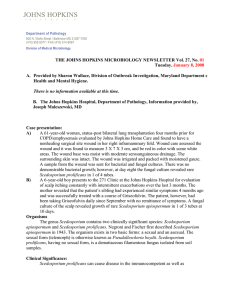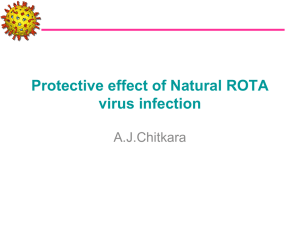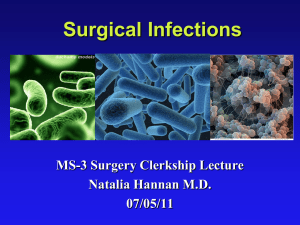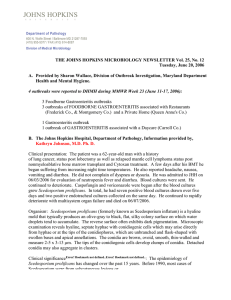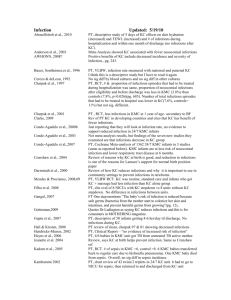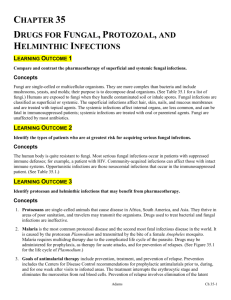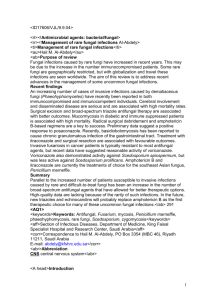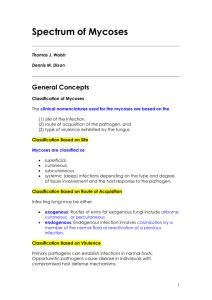Volume 24 - No 29: Scedosporium
advertisement
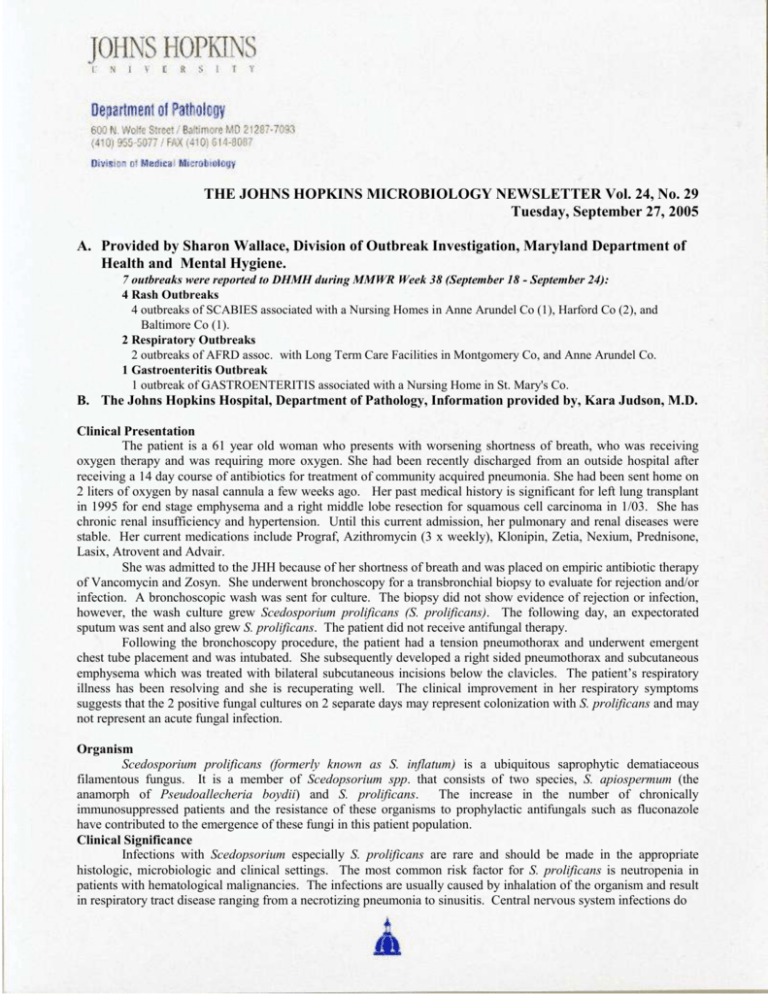
THE JOHNS HOPKINS MICROBIOLOGY NEWSLETTER Vol. 24, No. 29 Tuesday, September 27, 2005 A. Provided by Sharon Wallace, Division of Outbreak Investigation, Maryland Department of Health and Mental Hygiene. 7 outbreaks were reported to DHMH during MMWR Week 38 (September 18 - September 24): 4 Rash Outbreaks 4 outbreaks of SCABIES associated with a Nursing Homes in Anne Arundel Co (1), Harford Co (2), and Baltimore Co (1). 2 Respiratory Outbreaks 2 outbreaks of AFRD assoc. with Long Term Care Facilities in Montgomery Co, and Anne Arundel Co. 1 Gastroenteritis Outbreak 1 outbreak of GASTROENTERITIS associated with a Nursing Home in St. Mary's Co. B. The Johns Hopkins Hospital, Department of Pathology, Information provided by, Kara Judson, M.D. Clinical Presentation The patient is a 61 year old woman who presents with worsening shortness of breath, who was receiving oxygen therapy and was requiring more oxygen. She had been recently discharged from an outside hospital after receiving a 14 day course of antibiotics for treatment of community acquired pneumonia. She had been sent home on 2 liters of oxygen by nasal cannula a few weeks ago. Her past medical history is significant for left lung transplant in 1995 for end stage emphysema and a right middle lobe resection for squamous cell carcinoma in 1/03. She has chronic renal insufficiency and hypertension. Until this current admission, her pulmonary and renal diseases were stable. Her current medications include Prograf, Azithromycin (3 x weekly), Klonipin, Zetia, Nexium, Prednisone, Lasix, Atrovent and Advair. She was admitted to the JHH because of her shortness of breath and was placed on empiric antibiotic therapy of Vancomycin and Zosyn. She underwent bronchoscopy for a transbronchial biopsy to evaluate for rejection and/or infection. A bronchoscopic wash was sent for culture. The biopsy did not show evidence of rejection or infection, however, the wash culture grew Scedosporium prolificans (S. prolificans). The following day, an expectorated sputum was sent and also grew S. prolificans. The patient did not receive antifungal therapy. Following the bronchoscopy procedure, the patient had a tension pneumothorax and underwent emergent chest tube placement and was intubated. She subsequently developed a right sided pneumothorax and subcutaneous emphysema which was treated with bilateral subcutaneous incisions below the clavicles. The patient’s respiratory illness has been resolving and she is recuperating well. The clinical improvement in her respiratory symptoms suggests that the 2 positive fungal cultures on 2 separate days may represent colonization with S. prolificans and may not represent an acute fungal infection. Organism Scedosporium prolificans (formerly known as S. inflatum) is a ubiquitous saprophytic dematiaceous filamentous fungus. It is a member of Scedopsorium spp. that consists of two species, S. apiospermum (the anamorph of Pseudoallecheria boydii) and S. prolificans. The increase in the number of chronically immunosuppressed patients and the resistance of these organisms to prophylactic antifungals such as fluconazole have contributed to the emergence of these fungi in this patient population. Clinical Significance Infections with Scedopsorium especially S. prolificans are rare and should be made in the appropriate histologic, microbiologic and clinical settings. The most common risk factor for S. prolificans is neutropenia in patients with hematological malignancies. The infections are usually caused by inhalation of the organism and result vegetations tend to tract be large, localized the aleft side of the heart, andtoare often present more than oneinfections valve (4).do in respiratory disease rangingtofrom necrotizing pneumonia sinusitis. Centralon nervous system occur. Direct inoculation from a penetrating injury can lead to soft tissue or bone infections. In fact, immunocompetent patients are more likely to have chronic infections from this type of injury. Endophthalmitis may develop following a penetrating eye injuries. Disseminated infection with these fungi carries a poor prognosis, with a large number of patients dying as a result of their infection. The mortality rate has been estimated at 90% of patient with disseminated infection. This is due in large part to the poor activity of available antifungal agents. Epidemiology Scedosporium spp. can be found in soil, compost and animal manure. The organism was first described in 1984 by Malloch and Salkin as a human pathogen from a patient suffering from osteomyelitis. Infection occurs by inhalation of spores or by direct penetration from an injury. The exposure can result in colonization, local soft tissue or bone infection or disseminated disease. Immunocompetent patients can become colonized or have local infection from direct exposure. Immunocompromised patients are at risk for disseminated disease. There have been case reports of S. prolificans infections throughout the United States and Europe, with a majority of case reports from Spain, possibly due to the level of humidity found in Northern Spain. Laboratory Diagnosis Isolation of Scedosporium from a sterile body site is diagnostic, however, growth from the respiratory tract may indicate transient contamination, colonization or infection. Colonies grow rapidly and appear cottony, smoky gray to dark brown in color. Conidiophores can be short or long. Conidiogenous cells with hyaline annellides with or without swollen bases should be identified. S. prolifican growth is inhibited by cyclohexamide. Molecular techniques may be used for epidemiological studies during outbreaks. Scedosporium spp. resembles Aspergillus infections in tissue with septate hyphae and branching at acute angles. Treatment S. prolificans is a resistant organism to almost all antifungals in vitro and generally there is little success with treatment of this infection. Surgical debridement and resection when possible is as important as antifungal therapy. Use of colony stimulating factors in neutropenic patients has been reported to be of some benefit but the number of patients tested is quite small. The most appropriate treatment for these infections is incompletely understood. Treatment failures are common. S. apiospermum are resistant to amphotericin B, fluconazole and flucytosine and variably susceptible to itraconazole. This species is sensitive to miconazole and voriconazole. Early in vitro studies have shown that echinocandins and amphotericin B may have a synergistic effect against these fungi. Other studies have also demonstrated increased activity in vitro for combinations of antifungals including terbinafine with an azole. References: 1. Yustes, C and Guarro J. In Vitro Synergistic Interaction between AmphotericinB and Micafungin against Scedosporium species. Antimicrobial agents and Chemotherapy. 2005: 49 (8): 3498-3500. 2. Whyte, M, et al. Disseminated Scedosporium Prolificans Infection and Survival of a Child with Acute Lymphoblastic Leukemia. 2005: 24 (4): 375-377. 3. Schaenman, J, et al. Scedosporium apiospermum soft tissue infection successfully treated with voriconazole: potential pitfalls in the transition from intravenous to oral therapy. 2005; 43 (2): 973-7. 4. Al-abdely, H. Management of Rare Fungal Infections. Current Opinion in Infectious Diseases. 2004; 17 (6): 527-532. 5. Murray PR, et al. Manual of Clinical Microbiology, 8th edition. pgs 1820-1847. 6. Spelman, Denis. Miscellaneous and Emerging Fungal Infections. Up to Date. Oct 12, 2004.


